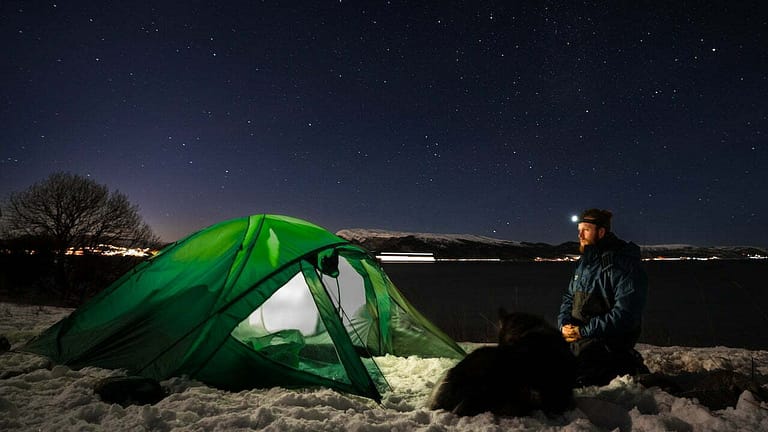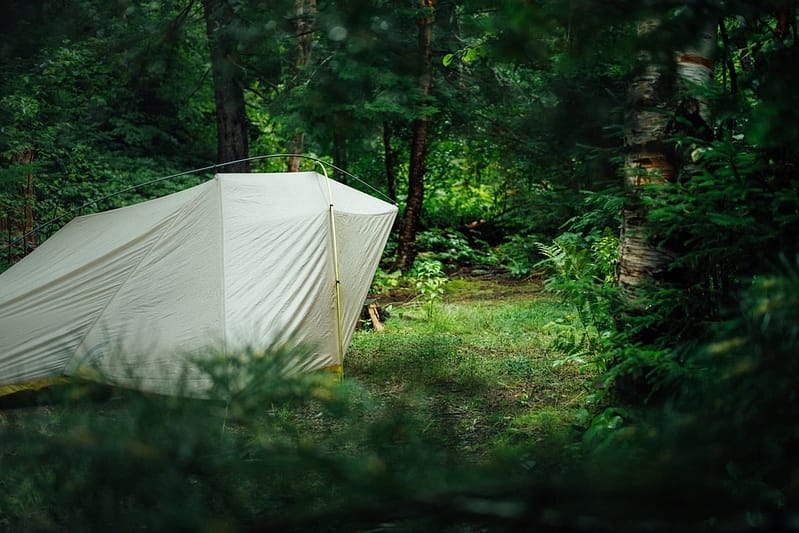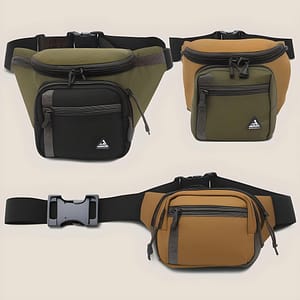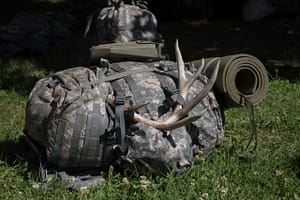Are you planning a winter camping trip and worried about staying warm in your tent? Don’t fret! With the right techniques, you can insulate your tent to create a cozy and comfortable haven even in freezing temperatures. In this blog post, we’ll guide you through the process of choosing the right tent, setting it up for maximum insulation, and insulating its floor, walls, and roof. We’ll also share some additional tips to help you stay warm throughout your winter adventure. Let’s dive in!
Choose the Right Tent for Winter Camping

A well-insulated tent is crucial for winter camping to keep you warm and comfortable in cold temperatures. Look for a four-season tent specifically designed to withstand harsh weather conditions, with features like reinforced poles and double-walled construction. Additionally, consider the size of your tent carefully; a smaller tent will be easier to heat and insulate than a larger one. Lastly, choose a tent with good ventilation to prevent condensation buildup inside, which can make you feel damp and colder.
Look for a Four-Season Tent
- Insulated walls and floors to keep you warm in cold weather
- Strong and durable materials that can withstand harsh conditions
- Snow skirts or flaps to prevent drafts from entering the tent
Consider the Tent Size
1. Opt for a smaller tent to retain body heat: When camping in cold weather, choosing a smaller tent can help you stay warm. A smaller space is easier to insulate and will trap your body heat more efficiently, keeping you cozy throughout the night.
Choosing a smaller tent can help retain body heat, keeping you warm in colder weather.
2. Look for a tent with extra space for gear storage: To keep your camping gear dry and prevent it from freezing in colder temperatures, consider a tent that offers additional space for gear storage. This way, you can keep your equipment protected while maximizing the insulation of your sleeping area.
3. Consider the number of occupants and their sleeping arrangements: When selecting a tent size, take into account the number of people who will be sharing it and their preferred sleeping arrangements. Ensuring everyone has enough room to sleep comfortably helps maintain warmth by avoiding cramped spaces that could lead to cold spots during chilly nights outdoors.
Pick a Tent with Good Ventilation
When choosing a tent for your camping adventures, it’s important to prioritize good ventilation. Here are some key factors to consider:
- Choose tents with adjustable vents or windows
- Look for mesh panels to promote airflow while keeping bugs out
- Ensure that ventilation can be controlled easily in case of extreme weather conditions
By selecting a tent with these features, you’ll be able to stay comfortable and well-ventilated during your camping trips, whether it’s hot or cold outside. Insulating your tent properly is crucial for maintaining a pleasant temperature inside, and having good ventilation will help regulate the airflow effectively. So make sure to pick a tent that prioritizes ventilation along with insulation!
Set Up Your Tent for Maximum Insulation

1. Select a campsite nestled among trees or natural windbreaks to shield your tent from cold drafts and maximize insulation. Avoid open, exposed areas that will expose your tent to harsh winds.
2. Lay down a groundsheet or footprint under your tent to provide an extra layer of insulation between the cold ground and the interior of your shelter. This will help prevent heat loss through conduction and keep you warmer throughout the night.
3. Ensure that you properly secure the rainfly over your tent, making sure it is tightly stretched and covers all sides evenly. A well-fitted rainfly acts as an additional barrier against cold air infiltration, adding another layer of insulation to keep you cozy inside.
Remember these tips when setting up your tent in colder weather conditions for maximum insulation against chilly temperatures during those winter camping trips.
Choose a Sheltered Campsite
Look for natural windbreaks like trees or shrubs to provide extra protection from cold winds and keep your tent insulated. Avoid setting up your tent in low-lying areas prone to cold air pockets, as these can make the temperature inside drop significantly. Instead, find a spot that receives ample sunlight during the day, as this will help warm up your tent and keep you cozy throughout the night.
Use a Groundsheet or Footprint
Invest in a high-quality groundsheet made of insulating materials. A good groundsheet will provide an additional layer of insulation between you and the cold ground, helping to keep you warm during winter camping trips.
Ensure the groundsheet is slightly larger than the tent footprint for better protection. This will prevent moisture from seeping under your tent and keep the interior dry.
Place an additional layer of thermal blanket under the groundsheet for extra insulation. This added barrier will further protect against heat loss and create a cozy sleeping environment inside your tent.
- Invest in a high-quality insulating groundsheet
- Use a slightly larger size than your tent footprint
- Add an extra layer of thermal blanket underneath it
Secure the Rainfly Properly
- Attach guy lines to all available points on the rainfly to minimize flapping in windy conditions.
- Tighten and adjust tension on guy lines regularly, especially after any weather changes.
- Consider using an additional reflective tarp over your rainfly for enhanced insulation.
Insulate the Floor of Your Tent

Add a layer of insulation: To insulate the floor of your tent, start by adding a layer of insulation. This can be done by placing a foam or thermal blanket underneath your sleeping bag. The insulation will help to trap heat and prevent it from escaping through the cold ground, keeping you warmer throughout the night.
Use a good quality sleeping pad: Another way to insulate the floor of your tent is by using a good quality sleeping pad. Opt for one that has an R-value suitable for colder temperatures, as this indicates its ability to provide insulation. A well-insulated sleeping pad will create a barrier between you and the cold ground, helping to keep you warm and comfortable during your camping trip.
Consider using a camping carpet: If you’re looking for extra comfort and insulation, consider using a camping carpet inside your tent. These carpets are designed specifically for outdoor use and can add an extra layer of warmth underfoot. Additionally, they help to minimize condensation that may form on the tent floor due to temperature differences between the inside and outside environments.
Remember that staying warm in winter while camping is crucial not only for comfort but also for safety. By taking these simple steps to insulate the floor of your tent, you’ll be better equipped to enjoy your outdoor adventure even when temperatures drop low.
Add a Layer of Insulation
Insulated groundsheet, foam mats, and reflective blankets are essential for adding a layer of insulation to your tent. An insulated groundsheet provides an extra barrier between the cold ground and your sleeping area, helping to retain heat. Foam mats offer cushioning while also insulating against the cold from below. Reflective blankets can be used as an additional layer inside your tent to reflect body heat back towards you for maximum warmth. By incorporating these insulation methods into your camping setup, you can ensure a cozy and comfortable sleep even in winter conditions.
Use a Good Quality Sleeping Pad
A Therm-a-Rest sleeping pad is an excellent choice for insulating your tent. With its innovative technology, it provides exceptional warmth and comfort during cold winter nights.
For added insulation, consider using a self-inflating mattress. These mattresses are designed with special materials that trap heat, keeping you cozy throughout the night.
Air mattresses with insulation are another great option for staying warm in winter. They provide both comfort and thermal protection, ensuring a good night’s sleep even in freezing temperatures.
Remember, investing in a good quality sleeping pad is essential to insulate your tent effectively and keep yourself warm during chilly nights outdoors.
Consider Using a Camping Carpet
Consider Using a Camping Carpet. Adding a camping carpet to your tent can provide an extra layer of insulation and comfort, making it an essential accessory for cold weather camping. Here are some options to consider:
- “Astroturf” artificial grass carpet:
- This type of carpet is durable and easy to clean, offering good insulation against the cold ground.
- EVA foam interlocking tiles:
- These lightweight and portable tiles create a soft and cushioned surface inside your tent while also providing insulation.
- Thick wool rugs:
- Wool rugs are known for their excellent insulating properties, keeping you warm during chilly nights.
Investing in a camping carpet will not only enhance your camping experience but also help keep you cozy during winter excursions.
Insulate the Walls of Your Tent
Hang blankets or curtains on the walls of your tent for a quick and easy way to insulate against the cold. The added layers will help trap heat inside and create a barrier between you and the chilly outdoors. Just make sure to secure them properly to ensure they stay in place throughout your camping trip.
Consider using reflective insulation panels to effectively insulate your tent walls. These panels are designed to reflect heat back into the space, keeping you warm even in freezing temperatures. Simply attach them directly onto the inner walls of your tent for maximum insulation benefits.
Apply an insulating spray foam to the walls of your tent for a more permanent solution. This foam expands upon application, filling any gaps or cracks in the fabric of your tent and providing excellent thermal insulation. Be sure to choose a foam that is specifically formulated for outdoor use, as it will be more resistant to moisture and temperature fluctuations.
By implementing these tips, you can significantly improve the warmth and comfort of your tent during winter camping trips. Stay cozy all night long with proper insulation techniques that keep cold air out and warmth in, ensuring an enjoyable outdoor experience regardless of how low temperatures drop outside.
Hang Blankets or Curtains on the Walls
1. Choose thick, insulating blankets or curtains to hang on your tent walls. These materials will help keep the cold air out and trap warmth inside, creating a cozy environment for you to sleep in.
2. Attach the blankets or curtains securely to the walls using hooks or clips. This ensures that they stay in place throughout the night, providing consistent insulation against the cold temperatures outside.
3. For enhanced insulation, consider creating a double layer by hanging an additional set of blankets or curtains on top of the first layer. This extra barrier adds an extra level of protection against heat loss and further improves your tent’s ability to retain warmth during winter camping trips.
Use Reflective Insulation Panels
Purchase reflective insulation panels specifically designed for tents. These panels are lightweight and easy to install, making them ideal for insulating your tent in colder weather.
Cut the panels to fit the dimensions of your tent’s walls. Measure and mark the panels carefully before using a sharp utility knife or scissors to cut them into the appropriate sizes.
Attach the panels securely using adhesive or Velcro strips. Apply a thin layer of adhesive along the edges of each panel and press firmly onto the tent walls. Alternatively, use Velcro strips by attaching one side to the back of each panel and sticking the corresponding side onto your tent’s walls for easy removal if needed.
Apply Insulating Spray Foam to the Walls
Ensure that your tent’s fabric is compatible with spray foam insulation. Different fabrics may react differently to the chemicals in the spray foam, so it’s important to check the compatibility before proceeding.
Clean and dry the walls before applying spray foam evenly. Any dirt or moisture on the walls can hinder adhesion, so make sure to thoroughly clean and dry them beforehand for optimal results.
Use a professional-grade spray foam formulated for outdoor use. Regular household insulation may not be suitable for outdoor conditions, so invest in a high-quality product specifically designed for outdoor applications to ensure long-lasting effectiveness.
Insulate the Roof of Your Tent

Add a tent insulation liner to keep warm in winter. These liners are designed to fit inside your tent and provide an extra layer of insulation. They can help trap heat and prevent cold air from seeping in, keeping you cozy throughout the night.
Consider using a double roof or flysheet for added insulation. This additional layer on top of your tent creates an insulating barrier that helps retain heat and block out cold drafts. It’s an effective way to stay warm during chilly nights while camping.
Attach insulated ceiling panels inside your tent for enhanced insulation. These panels can be easily installed by clipping them onto the roof of your tent, providing an extra layer of warmth and effectively reducing condensation buildup.
Use a Double Roof or Flysheet
Selecting a double roof or flysheet designed specifically for insulation is essential to keep your tent warm in winter. These specially designed covers have added layers and materials that provide better thermal protection against the cold. Make sure to install the double roof or flysheet properly, minimizing any air gaps that could let cold air inside. Additionally, consider using reflective materials on your double roof or flysheet for enhanced thermal insulation, ensuring maximum heat retention within your tent.
Attach Insulated Ceiling Panels
Identify lightweight and insulating materials for ceiling panels to maximize insulation while minimizing weight. This ensures efficient heat retention without compromising the structural integrity of your tent. Avoid obstructing ventilation openings when attaching panels, as proper airflow is crucial for maintaining a comfortable and healthy indoor environment. Secure the ceiling panels tightly to prevent slippage during windy conditions, ensuring that your insulation stays in place and maintains its effectiveness even in challenging weather conditions.
Other Tips for Staying Warm in Winter
Use a good sleeping pad to insulate your tent from the cold ground. The pad will provide an extra layer of insulation and prevent heat loss through conduction. Additionally, consider using a reflective blanket or tarp underneath your tent for added insulation.
Avoid wearing cotton clothing as it retains moisture and can make you feel colder. Opt for synthetic or wool fabrics that wick away moisture and provide better insulation. Layering your clothing is also essential as it traps warm air between layers, keeping you warmer in cold temperatures.
Wear Proper Clothing and Layers
Choose thermal underwear as your base layer to keep you warm and comfortable throughout the day. Layer up with insulating materials like fleece or down jackets for added warmth in colder temperatures. Complete your outfit by wearing a waterproof and windproof outer shell, providing protection against the elements to ensure maximum insulation inside your tent.
Use a Good Sleeping Bag
Look for a sleeping bag with a lower temperature rating than expected. Consider using a sleeping bag liner for added warmth. Ensure your sleeping bag is properly insulated, especially at the bottom.
- Look for a sleeping bag with lower temperature rating
- Use a sleeping bag liner for extra warmth
- Properly insulate your sleeping bag, especially at the bottom
Bring Hand and Foot Warmers
Pack disposable hand warmers to keep your hands cozy during cold nights. These compact and portable warmers provide steady heat for several hours, ensuring that your hands stay warm even in freezing temperatures. Don’t forget about foot warmers to prevent chilly toes while you sleep. Slip them into your socks or place them inside your shoes before bed, and wake up with toasty feet in the morning. For maximum effectiveness, place hand and foot warmers inside your sleeping bag or shoes where they will be directly against your skin.
Heat Up Rocks or Water Bottles
- Find large rocks near your campsite and heat them by placing them close to the fire. This will help retain heat for longer periods of time.
- Place heated rocks in cloth bags or socks, then strategically place them around your tent. The rocks will radiate heat and keep the interior of your tent warm throughout the night.
- Fill water bottles with hot water before bed and use them as makeshift heating pads. Place them at the foot of your sleeping bag to keep your feet warm during cold nights.
These simple techniques can provide additional insulation for your tent, ensuring a cozy and comfortable camping experience even in chilly winter conditions.
Use a Tent Heater with Caution
Only use tent heaters specifically designed for camping purposes to ensure safety and avoid potential hazards. Proper ventilation is crucial when using tent heaters to prevent carbon monoxide poisoning, so always keep windows or vents open. Additionally, maintain safety precautions by keeping flammable objects away from the heater at all times.
Avoid Cooking Inside Your Tent
Cooking inside tents can increase condensation levels, leading to a colder environment. To avoid this, it is best to cook outside in well-ventilated cooking areas. Additionally, open flame cooking methods should be avoided as they pose fire hazards.
Here You Can Find – The Best Camping Meals
Add a Tent Insulation Liner
Choose the right insulation liner material for your tent to effectively keep out the cold. Look for materials like closed-cell foam or synthetic fibers that provide excellent thermal insulation.
Install the insulation liner properly by attaching it securely to the interior of your tent walls. Make sure there are no gaps or openings that could let in drafts, and ensure a snug fit to maximize its insulating properties.
Consider additional features such as reflective surfaces or enhanced thermal properties when selecting an insulation liner. These can help reflect heat back into the tent and improve overall warmth during chilly nights.





